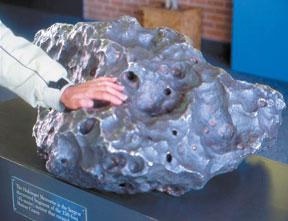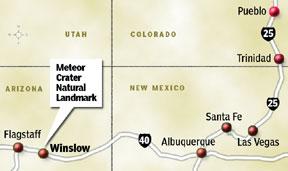But looks, as they say, can be deceiving.
Some 50,000 years ago, a meteorite slammed into this wind-swept plateau, spewing molten fragments over the surrounding landscape and creating the world's best-preserved, and first scientifically authenticated, meteorite impact crater.
Standing on one of the crater's four outdoor observation platforms, it's difficult to imagine how a rock could have gouged out this gaping, bowl-shaped depression that measures more than 4,000 feet across and is deeper than a 60-story building is tall.
But then we're talking about a chunk of iron that weighed 330,000 tons, traveled at an estimated 40,000 mph - a speed that would have propelled it across the entire continental United States in about four minutes - and crashed to Earth with the explosive force of approximately 20 million tons of TNT. The Canyon Diablo meteorite, as it's called, was originally part of an asteroid. These small, celestial "leftovers" from the formation of the solar system are primarily located in an area of interplanetary space between the orbits of Mars and Jupiter. A half-billion years ago, some sort of otherworldly collision shattered this particular asteroid, hurling part of it into space, where it cruised around harmlessly for eons before crossing paths with our world.
Despite melting, disintegrating and partially vaporizing upon impact, the Canyon Diablo meteorite still left behind enough of itself - more than 15 tons have been recovered, with some fragments scattered as far as 6 miles from the crater's center - for scientists to categorize it as an iron meteorite. One of three types of meteorites (the other two are called stony and stony-iron), the Canyon Diablo meteorite is composed of 92 percent iron and 7.1 percent nickel, along with traces of such rare metallic elements as gallium, iridium and germanium.
Visitors can actually touch the largest piece of the Canyon Diablo meteorite found to date, a pockmarked, silvery-black, 1,406-pound space rock called the Holsinger meteorite in honor of discoverer S.F. Holsinger, an early explorer of the crater. This meteorite is on display at the adjoining Meteor Crater Museum and Interactive Learning Center, which houses, in addition to its impressive meteorite collection, an 80-seat, wide-screen theater featuring the short film "Collisions and Impacts," along with more than two dozen interpretive, hands-on and interactive displays. Topics range from the history and geology of Meteor Crater to Comet Shoemaker-Levy 9, which crashed into the planet Jupiter in 1994, and the ongoing search by Flagstaff's Lowell Observatory for "near-Earth objects," celestial bodies that could conceivably pose a threat to our planet.

A video magnifier enables us to examine the differences between rocks formed under normal Earth temperatures and pressures and rocks that have been moderately to severely "shocked." Shocked rocks have been exposed to explosive forces like that generated by an atomic blast - or a meteorite impact. This subjects the rocks to temperatures and pressures high enough to alter their crystalline structure, sometimes into forms that do not occur naturally on Earth.
We even step inside the "Put Yourself at Ground Zero" exhibit to get a sense of what it might have felt like in the impact zone when the Canyon Diablo meteorite hit - minus, fortunately, the sensations of being instantly vaporized by clouds of dense, super-heated gas or crushed by the 175 million tons of sandstone and limestone that were displaced by the collision and explosion. Some of this debris forms the rim of Meteor Crater, which rises 150 feet above the otherwise flat plain. And when snowfall cancels this day's regularly scheduled, guided walking tours of a portion of the crater rim, we spend extra time at the site's Astronaut Park picnic area, where we peer inside a 1965 Apollo test capsule and peruse the American Astronaut Wall of Fame commemorating astronauts from the Mercury, Gemini and Apollo space programs.
Because of its resemblance to lunar-surface impact craters, the National Aeronautics and Space Administration (NASA) used Meteor Crater as a training site for its Apollo-program astronauts. Designed to land humans on the moon and bring them safely back to Earth, the Apollo program achieved that goal six times between July 1969, when the crew of Apollo 11 made mankind's first lunar landing, and the final Apollo moon mission in December 1972.
The late Dr. Eugene M. Shoemaker, co-discoverer of Comet Shoemaker-Levy 9, helped train the Apollo astronauts at Meteor Crater. Shoemaker, who wrote his doctoral thesis on the crater, was renowned for his work on extraterrestrial impacts and the mechanics of meteorite impacts, and for his co-discovery of coesite, a shocked form of quartz rarely found naturally on Earth.
The floor of Meteor Crater has been partially filled by centuries of accumulated rock and debris from its original, post-impact depth of 700 feet to its current depth of just over 550 feet. The floor is considered a scientific laboratory, making it off-limits to the general public.
Hollywood has had better luck gaining access to it.
Several movies have been filmed here, including the 1984 classic "Starman," in which a celestial voyager played by actor Jeff Bridges rendezvoused with the mother ship at Meteor Crater.
Heck, if I were an alien (and some might question my use of the word "if"), I'd also want to blast off from Meteor Crater. It would make a great starting point for what would certainly be one long, strange trip.
Another name
Meteor Crater, the main attraction at Meteor Crater Natural Landmark, is also known in scientific circles as the Barringer Meteor Crater. It is named after Daniel Moreau Barringer, a Philadelphia mining engineer and lawyer who correctly identified the crater's impact origin more than a century ago.




Reader Comments
to our Newsletter